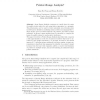Free Online Productivity Tools
i2Speak
i2Symbol
i2OCR
iTex2Img
iWeb2Print
iWeb2Shot
i2Type
iPdf2Split
iPdf2Merge
i2Bopomofo
i2Arabic
i2Style
i2Image
i2PDF
iLatex2Rtf
Sci2ools
SAS
2004
Springer
2004
Springer
Pointer-Range Analysis
Array-Range Analysis computes at compile time the range of possible index values for each array-index expression in a program. This information can be used to detect potential out-of-bounds array accesses and to identify non-aliasing array accesses. In a language like C, where arrays can be accessed indirectly via pointers, and where pointer arithmetic is allowed, range analysis must be extended to compute the range of possible values for each pointer dereference. This paper describes a Pointer-Range Analysis algorithm that computes a safe approximation of the set of memory locations that may be accessed by each pointer dereference. To properly account for non-trivial aspects of C, including pointer arithmetic and type-casting, a range representation is described that separates the identity of a pointer’s target location from its type; this separation allows a concise representation of pointers to multiple arrays, and precise handling of mismatched-type pointer arithmetic.
| Added | 02 Jul 2010 |
| Updated | 02 Jul 2010 |
| Type | Conference |
| Year | 2004 |
| Where | SAS |
| Authors | Suan Hsi Yong, Susan Horwitz |
Comments (0)

